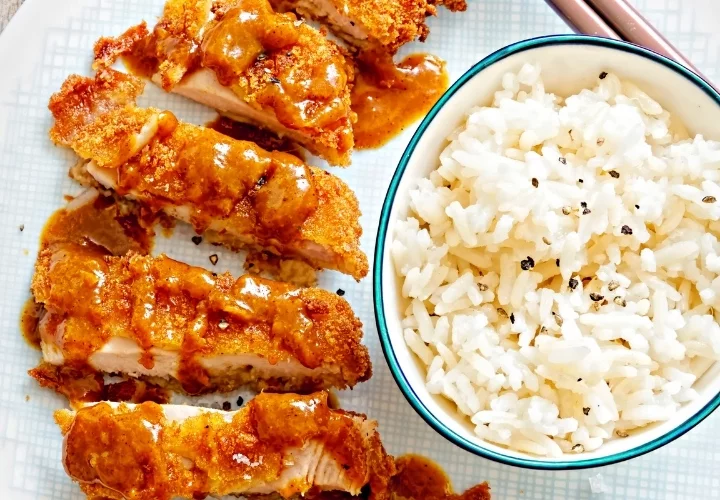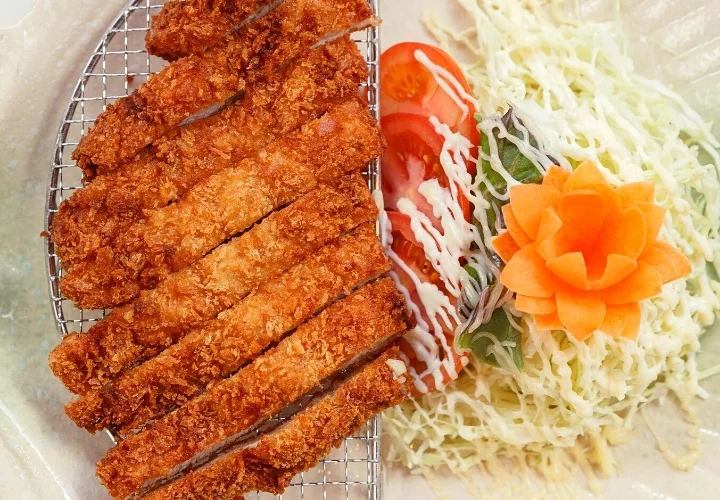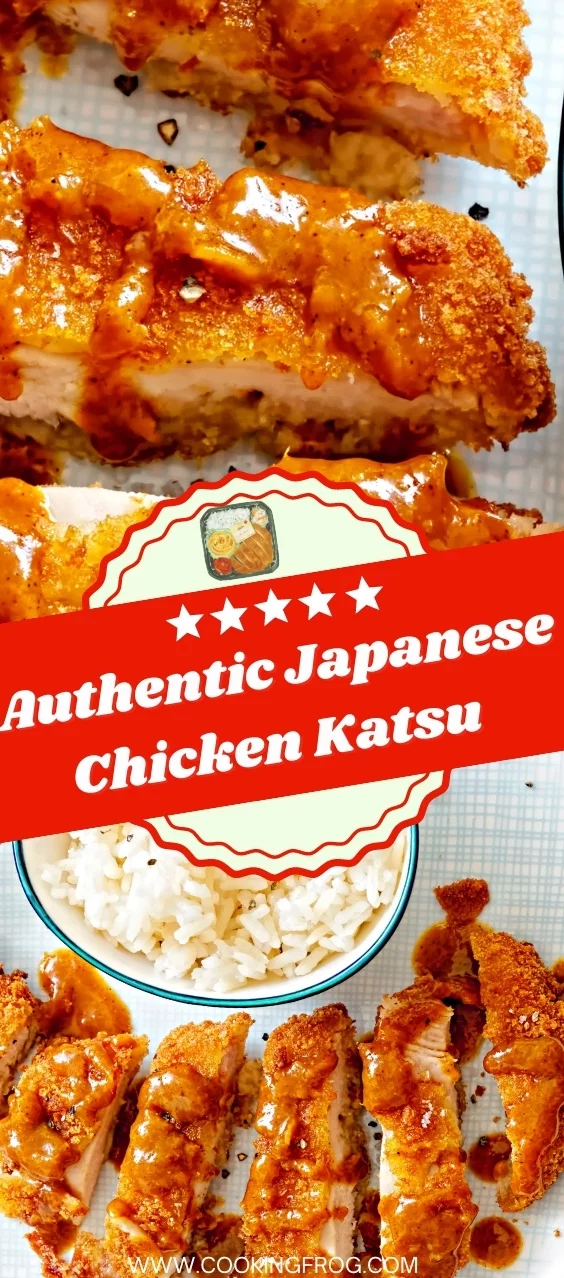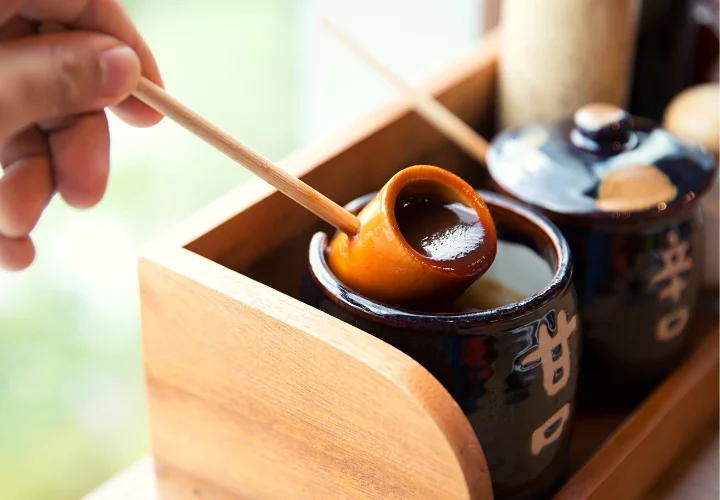Have you ever tasted a Japanese restaurant’s Chicken Katsu? This mouthwatering boneless chicken cutlet is simple to prepare at home. Make these chicken Katsu at home in a matter of minutes rather than going out to eat!
And what is Chicken Katsu without the famous Japanese Tonkatsu sauce? That is why I’ve included both recipes in this article, so you have them all in one place. 🙂
What is Chicken Katsu?
The Japanese word katsu (かつ), which translates to “cutlet” in English, denotes meat that has been thinly beaten before cooking. Panko chicken or tori katsu are other names for the Japanese dish chicken katsu.
Imagine it as fried chicken prepared in the Japanese way. Panko breadcrumbs, which become so delicate and crunchy when baked, are used to cover the seasoned chicken. The flavor of luscious, moist chicken follows a pleasant crunch.
Tonkatsu sauce, a thick and acidic Japanese vegetarian brown sauce, and white rice are the usual accompaniments for chicken katsu in Japan. (The recipe for this sauce is provided in the recipe section at the end of the article.) Making a Japanese meal need not be intimidating; this one is quite simple.
Tonkatsu (Japanese-style fried pork) may be made using this simple chicken katsu recipe; simply swap out the chicken with pork cutlets.
The 19th-century Japanese dish known as katsu is now highly well-liked in locations like Maui, Sidney, and other world regions. The generations of Japanese immigrants that came to the islands and influenced the indigenous cuisine are to be credited for its popularity in Hawaii.
Ingredients
For the Chicken Katsu
-
1 (10 oz) chicken breast, boneless and skinless
-
½ tsp kosher salt
-
⅛ tsp freshly ground black pepper
-
1 large egg
-
½ Tbsp neutral oil (canola or vegetable oil)
-
3 Tbsp all-purpose flour
-
1 cup Japanese panko breadcrumbs
-
3 cups neutral oil, for frying
For the Tonkatsu Sauce
-
½ cup ketchup
-
2 Tbsp soy sauce
-
1 Tbsp brown sugar
-
1 Tbsp mirin
-
1 ½ tsp Worcestershire sauce
-
1 tsp fresh ginger, grated
-
1 garlic clove, minced
For Serving (Optional)
-
Shredded cabbage with Japanese sesame dressing
-
1 tomato, sliced
-
Extra tonkatsu sauce
Instructions
1. Butterfly & pound the chicken
-
Butterfly the chicken breast by slicing horizontally almost all the way through, then open it like a book.
-
Cut into two pieces and pound to an even thickness of ¼–½ inch (7 mm–1.4 cm).
-
Season both sides with salt and black pepper.
2. Set up breading station
-
Prepare three shallow dishes: flour, egg (beaten with ½ Tbsp oil), and panko breadcrumbs.
-
Coat the chicken lightly in flour, shaking off excess.
-
Dip into the egg mixture.
-
Press firmly into the panko, coating evenly. Set aside.
3. Heat the oil
-
In a heavy-bottomed pot, heat oil to 340°F (170°C). The oil should be about 1 ½ inches deep.
-
Test by dropping in a breadcrumb — it should sizzle immediately.
4. Fry the chicken
-
Fry one piece at a time, avoiding overcrowding.
-
Cook for 3–4 minutes per side, flipping once, until golden brown and crisp.
-
Hold vertically to drain excess oil, then transfer to a wire rack or paper towel–lined tray.
-
Skim out crumbs between batches to keep oil clean.
5. Make the tonkatsu sauce
-
In a small bowl, whisk together ketchup, soy sauce, brown sugar, mirin, Worcestershire sauce, ginger, and garlic.
-
Let sit for 20–30 minutes to allow flavors to blend.
6. Serve
Slice chicken into strips and serve immediately with tonkatsu sauce. Add shredded cabbage, fresh tomato, or rice for a complete meal.
Tips for Success
-
Keep oil at the right temp: Too hot = burnt crust, too cool = greasy chicken.
-
Add oil to the egg: Helps the coating crisp up evenly.
-
Wire rack > paper towels: Keeps the coating crunchy while draining.
Share the image below to your Pinterest board if you’ve enjoyed this Authentic Chicken Katsu Recipe!
What does Chicken Katsu taste like?
Because of its seasoning and breaded coating, chicken katsu has a savory taste and crispy texture, while the katsu sauce adds a tangy and somewhat sweet taste.
If you’ve never had Chicken Katsu, it is essentially a deep-fried, crispy, crunchy, and juicy chicken with a tonkatsu sauce that creates a unique blend of tastes. You will like this flavor if you enjoy chicken tenders or cutlets.
Chicken Katsu is one of the chicken entrees you might order that is most accessible if you have never gone to a Japanese restaurant. It resembles a gourmet version of fried chicken, but better.
What are panko breadcrumbs?
If panko is unfamiliar to you, don’t worry; it’s neither unusual nor difficult. Simply said, panko is a kind of breadcrumb that differs somewhat from regular breadcrumbs. The type of white bread from which panko is formed makes a difference. The term “panko,” which is taken from a Japanese word, is often used in Japanese cuisine for light breading.
Compared to regular breadcrumbs, panko breadcrumbs are crispier, lighter, and fluffier. Panko produces a fantastic light and crispy coating since it is not dense, and so absorbs less fat and grease. Panko may be made at home, purchased at most stores, and of course, ordered online.
What is tonkatsu sauce?
Tonkatsu sauce, also known as Chicken Katsu sauce, is a barbecue sauce from Japan. It is thick and tangy and ideal for spreading on sandwiches or dipping your favorite fried foods in. This sauce is also available pre-made for purchase.
With items you likely already have on hand, such as Worcestershire sauce, ketchup, soy sauce, and a little piece of freshly chopped garlic or garlic powder, you can easily prepare this sauce on your own, and we’ll show you how.
What does tonkatsu sauce taste like?
If you’ve never had this savory sauce, it tastes something like sauces used for steaks but has a little distinct kick from the soy sauce. It is the ideal sauce for this meal, and you might want to try it with different fried meats because it’s so simple to create, and you always have plenty when you learn how to make it in your kitchen.
Tonkatsu sauce is delicious on pork, beef, and chicken. Even french fries were dipped in it by me, but that’s just me, you don’t need to replicate everything I do! If you’ve followed my blog, you know how much I like to experiment with food. However, I always post only recipes that are proven to be great 🙂
How to Make Chicken Katsu
These are the Ingredients You’ll Need
- Chicken breast – Although you may also use chicken tenders or chicken thighs, skinless and boneless chicken breast is the most suitable choice. When I was younger, my granny used to make it frequently using chicken tenders, and I did the same for some time till I realized chicken breasts were the best option.
- Flour
- Panko (Japanese breadcrumbs)
- Tonkatsu sauce
- salt and pepper
- Eggs
- Deep-frying oil (homemade or store-bought)
As you can see, the majority of the components for chicken katsu are standard items that are generally accessible wherever you go.
Quick Overview of Chicken Katsu Cooking Steps
- Chicken should be butterflied and seasoned with salt and pepper.
- Use panko, egg, and flour to coat the chicken.
- Cook the chicken until it reaches golden brown color. Serve with tonkatsu sauce.
As you can see, as easy as 1,2,3, deep frying Chicken Katsu is a simple three-step method, and with tonkatsu sauce, you’ll get a restaurant-quality dish!
Tips for Making the Best Chicken Katsu
Butterflying the chicken katsu
A chicken breast’s thickest portion can be as much as 1 inch (2.5 cm) thick, and it is extremely challenging to cook all the way through. To butterfly a chicken breast, split it horizontally, stop before cutting all the way through, and unfold it like a book.
The chicken breast has two identical sides when you open it, making it look like a butterfly. To make it even for Japanese cooking, we butterfly it to the right and left sides, much like a French door. This cutting method is known as “Kannon Biraki.”
You may also chop the chicken into bite-sized pieces if you have small kids. It’s interesting to note that we do not, whereas many Japanese home chefs chop their chicken into bite-sized pieces.
You can use a Japanese cutting method called “sogigiri” to split food into smaller pieces. Slice the chicken while holding the knife at an angle almost parallel to the cutting board. By flattening the piece, you may increase the chicken’s contact area and cook it more quickly and uniformly.
Finally, remember that they use chopsticks to consume chicken katsu in Japan. To avoid having to cut at the table, be sure to chop into smaller pieces either before or after frying.
Adding oil to the Chicken Katsu egg mixture
The Chicken Katsu egg mixture benefits from a modest amount of oil added to assist the meat sticking to the flour and panko. Some people thin the thick egg mixture using milk or water, but a little oil also thins the Chicken Katsu egg mixture while accomplishing the task.
Make sure you have Japanese panko breadcrumbs.
I won’t advise using regular breadcrumbs because they are very different from Japanese panko.
Japanese breadcrumbs, known as panko, are thinner and crispier. It produces the type of crust you can almost hear as you take a bite into it and is the key to extremely crispy Chicken katsu. Nothing beats that, so again, don’t use regular breadcrumbs for this recipe!
Remove excess panko breadcrumbs and flour.
When you cover the chicken breast with flour, shake off any extra. The ease with which the breading falls off your meat may be due to too much flour.
If you enjoy the panko’s texture, you might wish to add extra to the chicken katsu. When I was nine years old and assisting my grandma, I used to believe the same thing. I didn’t trust her when she said that all the extra panko would simply fall off into the oil (because I wasn’t the one doing the deep-frying).
However, cooking is a skill; adding more doesn’t always work. All those extra panko crumbs would land in your hands once you removed them from the hot oil. It isn’t worthwhile.
Use your hand to press the panko into place gently; if any panko comes off, let them go. Later, we’ll concentrate on deep-frying advice for Chicken Katsu.
Katsu Chicken & Tonkatsu sauce
Tonkatsu, or So-su in Japanese, is the name of the sauce that is served with Chicken Katsu. Tonkatsu Sauce, basically a richer and sweeter variation of Worcestershire sauce, is what in Japan refers to when they say so-su, or “sauce.”
The finest sauce to pair with Japanese deep-fried foods is tonkatsu sauce, which has a tangy and rich flavor from veggies and fruits. Tonkatsu sauce is frequently offered alongside Korokke, another amazing Japanese dish.
Making this sauce from scratch at home is uncommon since it takes a long time to simmer the fruits and veggies. Bulldog brand tonkatsu sauce is the most widely used brand, and we often get it online.
But no worries, I’ve prepared homemade tonkatsu sauce using readily accessible everyday ingredients for those of you who do not have access to tonkatsu sauce.
Shredded cabbage salad goes best with Chicken Katsu
Tonkatsu, Ebi Fry, Korokke, and other panko-breaded fried delicacies are frequently served in Japan over a side of finely shredded cabbage. You can chop the cabbage into tiny slices with a sharp knife, but my grandma showed me how to use this fantastic mandolin slicer, which produces fluffy shreds of cabbage.
You may add your preferred salad dressing or sprinkle tonkatsu sauce over the cabbage. To balance the tonkatsu sauce, I nearly always use Japanese sesame dressing since it is light and creamy.
Deep Frying Tips For Chicken Katsu
Let me start by saying that deep-frying is not as scary as it appears. Once you master the method, you can cook up additional delectable katsu dinners that will satisfy even the pickiest eaters. Every Japanese home cook prefers Deep-frying for this reason.
These three recommendations will help you cook these crunchy, juicy chicken katsu at home.
- Instead of using a huge pot or pan, use a medium-sized pot that can fit the chicken. A minimum of 1.5 inches (3.5 cm) of oil must be available for frying. You will need extra oil to reach a depth of 1 inch in a big pot or pan. I use Cast Iron Round Skillet (8 inches or 19 cm in diameter).
- To test the temperature of the oil, use a kitchen thermometer. This immediate reading thermometer comes highly recommended. If you’ve never deep-fried before, it’s advisable to use a kitchen thermometer rather than estimating yourself because the outcome might not be correct. 340 F (170 C) is the ideal oil temperature for katsu.
- Start picking up crumbs constantly; I cannot emphasize how crucial this is. If you don’t pick up dropped breadcrumbs in the oil, they will continue to burn and cause the oil to get black and soiled.
Although deep-frying food might be challenging, if done correctly, the dish really tastes light and not at all oily. Deep frying requires work to become comfortable with, but it’s a useful skill to have to increase your range of culinary alternatives.
FAQs
For how long can I store Chicken Katsu?
For two to three days, chicken katsu can be stored in the refrigerator in an airtight container.
Reheating the breaded chicken in the oven or toaster oven is the only method to restore its crispiness. Never reheat in the microwave.
Can I freeze chicken katsu?
Every time I double a recipe, I freeze the extra and use it for another supper or the kids’ meals. The chicken should be well cooled after deep frying before being placed in an airtight container to freeze.
Whenever it’s time to serve, warm the frozen chicken katsu on a baking sheet in a 350°F (176°C) oven for 15 to 20 minutes before dipping it in Tonkatsu sauce.
Can Chicken Katsu be Baked?
Yeah! You may bake the chicken katsu in the oven if you still desire to keep your cooking oil-free. The panko is pre-toasted in my recipe for baked chicken katsu.
The panko will start out well-browned and crispy in this manner. The outside of your baked chicken katsu is light and crispy, like a deep-fried version.





